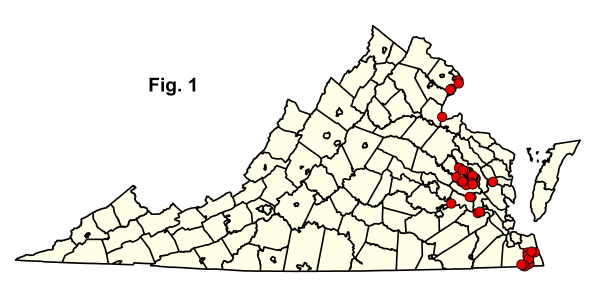
 自然保护与休闲部
自然保护与休闲部保护·守护·共享
 自然保护与休闲部
自然保护与休闲部 目录
目录潮汐沼泽森林和林地
该组包括内陆沿海平原河流及其支流上游潮汐河段以及弗吉尼亚州东南部风潮河口上游受潮汐影响地区的所有森林和林地。河口系统中森林植被的发育和持续似乎受到下游盐度和上游沉积物是否充足的限制。
Tidal hardwood swamps occur along all of the major eastern Virginia rivers from the James River northward, but are most extensively developed along the Pamunkey and Mattaponi Rivers, where regular tidal inundation is unimpeded by levees or channel alteration. Its habitats are influenced by lunar tides up to 1 m (3 ft), but diluting freshwater flows from upstream keep salinity levels below 0.5 ppt. Communities in this group are structurally complex, with semi-open overstories and diverse multiple lower strata. Pumpkin ash (Fraxinus profunda) and swamp tupelo (Nyssa biflora) are the most abundant overstory species, with occasional associates of red maple (Acer rubrum), green ash (Fraxinus pennsylvanica), sweetgum (Liquidambar styraciflua), swamp chestnut oak (Quercus michauxii), common persimmon (Diospyros virginiana), and black gum (Nyssa sylvatica). From the Potomac River north, green ash becomes increasingly important and largely replaces pumpkin ash as an overstory dominant in northern Virginia. Shrub layers are mixed and extraordinarily diverse. Common species include winterberry (Ilex verticillata), smooth alder (Alnus serrulata), southern wild raisin (Viburnum nudum), arrow-wood (Viburnum dentatum), wax myrtle (Morella cerifera), American holly (Ilex opaca var. opaca), fetterbush (Eubotrys racemosus), spicebush (Lindera benzoin var. benzoin and var. pubescens), sweetbay magnolia (Magnolia virginiana var. virginiana), swamp rose (Rosa palustris), silky dogwood (Cornus amomum) stiff dogwood (Cornus foemina) , and Virginia-willow (Itea virginica). Climbing vines such as poison ivy (Toxicodendron radicans var. radicans), Virginia-creeper (Parthenocissus quinquefolia), and greenbriers (Smilax spp.) are also common. Herb layers are rich with a wide variety of wetland ferns, graminoids, and forbs. Characteristic herbs are halberd-leaf tearthumb (Persicaria arifolia), groundnut (Apios americana), rice cutgrass (Leersia oryzoides), arrow-arum (Peltandra virginica), false nettle (Boehmeria cylindrica), water-hemlock (Cicuta maculata var. maculata), Virginia dayflower (Commelina virginica), lizard's-tail (Saururus cernuus), fringed sedge (Carex crinita), orange jewelweed (Impatiens capensis), Canada mint (Mentha canadensis ), royal fern (Osmunda spectabilis), cowbane (Oxypolis rigidior), and greater marsh St. John's-wort (Triadenum walteri). Stands transitional between more closed forest and open marsh may contain abundant wild rice (Zizania aquatica var. aquatica).
潮汐硬木沼泽栖息地的一个重要特征是明显的丘陵和凹陷微地形,其中高于最高潮位的凸起区域为树木的建立提供了稳定的基质,并为更多中生森林草本植物提供了微生境。这些沼泽森林还为隐秘的动物物种提供了栖息地,例如原鼻莺( Protonataria citrea )和二趾莺( Amphium amphiuma ),以及更引人注目的物种,包括白头鹰( Haliaeeatus leucocephalus )。潮汐硬木沼泽在全球范围内被认为是罕见的,并且受到入侵草本植物沼泽露花( Murdannia keisak )、慢性海平面上升和昆虫病原体的威胁。几十年来,树冠枯萎和树木死亡几乎是这些群落中普遍存在的现象,一般将其归因于海平面上升和盐度梯度的上游变化。然而,在过去十年中,外来入侵的翡翠灰螟的爆发已导致许多林分中主要白蜡树灾难性地死亡。在一些地方,树木密度现在非常低,以至于淡水沼泽植被正在重新占领栖息地。

以落羽杉 ( Taxodium distichum ) 为主的针叶林或混合沼泽森林和林地仅在马里兰州、弗吉尼亚州东南部和北卡罗来纳州的河流上游潮汐区发现。弗吉尼亚州有记录的例子,包括月潮龙沼泽/皮安卡坦克河(格洛斯特县、国王与王后县和米德尔塞克斯县)、奇卡霍米尼河(查尔斯城县、詹姆斯城县和新肯特县)和詹姆斯河(怀特岛县和萨里县);以及风潮西北河和北登陆河(切萨皮克市和弗吉尼亚海滩)。在某些地区,这些群落出现在潮汐沼泽和非潮汐沼泽或高地之间的生态交错带中。
在月潮林中,落羽杉( Taxodium distichum )占据了开阔至非常开阔的林冠层,有或没有硬木伴生,例如沼泽黄杨( Nyssa biflora )、水黄杨( Nyssa aquatica )和绿梣( Fraxinus pennsylvanica )。林分结构和树冠覆盖范围从密林到非常开阔的林地。灌木和草本层多种多样,但通常包含沼泽和沼泽地特征的物种混合物。一些发育良好的潮汐落羽杉森林在植物种类上与沼泽落羽杉-沼泽地相似。其他林分几乎以单一种类的草本植物为主,其中以海岸莎草( Carex hyalinolepis )为主。在西北河上一个独特的、可能受火灾影响的类似稀树草原的地区,按大致的季节顺序,占优势的草本植物是银色莎草( Carex canescens var.disjuncta )、spikerushes ( Eleocharis Fallax和Eleocharis rostellata )、响尾蛇大师 ( Eryngium Aquaticum )和茭白( Zizania Aquatica var. Aquatica )。
A distinctive, mixed tidal swamp forest in extreme southeastern Virginia is subject to irregular wind-tidal flooding. As currently defined, this community type appears to be a globally rare endemic of the Embayed Region of southeastern Virginia and northeastern North Carolina; similar communities, however, occur occasionally further north on the irregularly flooded edges of lunar-tidal systems. In Virginia, stands occur primarily along the North Landing and Northwest Rivers (Cities of Virginia Beach and Chesapeake), estuarine tributaries of Currituck Sound. Although these systems are no longer influenced by lunar tides because of inlet closures, they are subject to wind-driven currents that produce as much as 1 m (3 ft) of variation in water levels and contribute to a salinity regime that fluctuates between completely fresh and about 5 ppt. This forest borders the wind-tidal marshes along the lower portions of the two rivers, extending well upstream of the limit of marshes in narrowing channel-side belts. It appears to represent a long-term seral stage in succession from marsh to swamp forest. Habitats have a pronounced hummock-and-hollow microtopography, with an average flooding depth 40 cm (16 in) above the hollow bottoms. Soils are coarse, fibric peats that appear indistinguishable from adjacent marsh peats. Swamp tupelo (Nyssa biflora), bald cypress (Taxodium distichum), and loblolly pine (Pinus taeda) are the dominant overstory trees in variable combinations. Spanish-moss (Tillandsia usneoides) is locally abundant, festooning the trees in some stands. Sweetbay magnolia (Magnolia virginiana var. virginiana) and red bay (Persea palustris) are scattered understory trees, while wax myrtle (Morella cerifera) dominates the shrub layer. The herb layer is diverse, containing species characteristic of both marshes and swamps, but royal fern (Osmunda spectabilis) often dominates.
潮汐落羽杉森林和林地的环境动态、成分变化和全州分布尚不为人所知,需要深入研究。
参考文献:Ahnert ( 1960 )、Coulling ( 2002 )、Doumlele 等人。( 1985 )、弗莱明和摩尔黑德( 1998 )、麦考伊和弗莱明( 2000 )、莱因哈特( 1992 )。
 © DCR-DNH,加里·P·弗莱明。
© DCR-DNH,加里·P·弗莱明。

 下载下面列出的每个社区类型的组成汇总统计电子表格。
下载下面列出的每个社区类型的组成汇总统计电子表格。 
